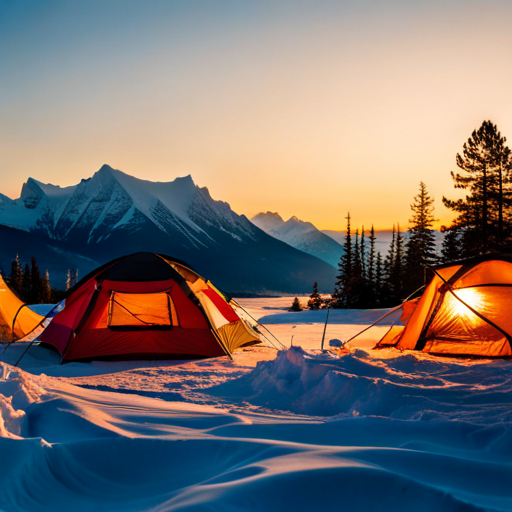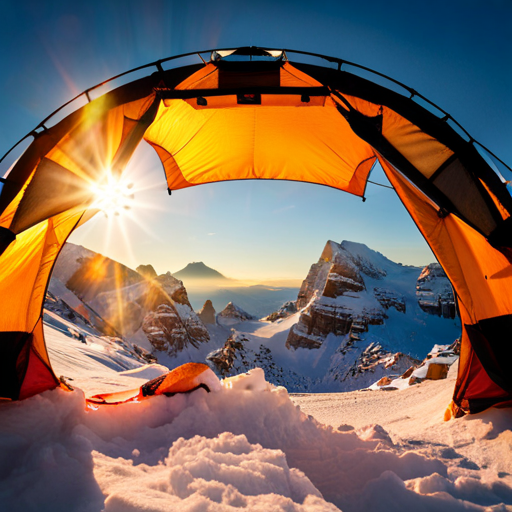Table of Contents
- Insulation and Temperature Ratings: Staying Warm and Cozy in Your Cold Weather Tent
- Material Selection for Cold Weather Tents: Durability, Weather Resistance, and Weight
- Ventilation and Condensation Management in Cold Weather Tents
- Ease of Setup and Takedown: Choosing a Cold Weather Tent That Saves Time and Effort
- Frequently Asked Questions
Winter camping can be an exhilarating experience, offering campers a unique opportunity to explore the great outdoors in a serene and tranquil setting. However, as temperatures drop, it becomes increasingly important to ensure that you are well-equipped to face the challenges of cold weather camping. One of the most crucial pieces of gear for any winter adventure is a reliable cold weather tent. In this Ultimate Guide to Cold Weather Tents, we will delve into the essential factors to consider when selecting the perfect tent for your 2023 winter escapades, including insulation and temperature ratings, material selection, ventilation and condensation management, and ease of setup and takedown.
Insulation and Temperature Ratings: Staying Warm and Cozy in Your Cold Weather Tent

To stay warm and cozy in a cold weather tent, consider insulation and temperature ratings. Insulation materials, such as synthetic or down fill, help trap heat inside the tent. Temperature ratings indicate the lowest temperature at which a tent can provide adequate warmth. Choose a tent with a rating lower than the expected weather conditions to ensure comfort and safety during your camping adventure. Remember, personal factors like clothing and sleeping gear can also affect overall warmth inside the tent.
Material Selection for Cold Weather Tents: Durability, Weather Resistance, and Weight

When selecting materials for cold weather tents, prioritize durability, weather resistance, and weight. Opt for high-quality, tear-resistant fabrics like ripstop nylon or polyester, ensuring longevity. Seek materials with excellent weather resistance, such as waterproof coatings and seam sealing, to withstand snow and rain. Lastly, consider weight, as lighter materials ease transportation but may compromise durability or insulation. Striking a balance between these factors will result in a reliable and comfortable cold weather tent.
Ventilation and Condensation Management in Cold Weather Tents

Proper ventilation in cold weather tents is crucial for managing condensation, maintaining fresh air, and preventing dampness. Look for tents with adjustable vents or mesh windows that allow airflow without letting cold air in. Additionally, a breathable tent fabric aids in moisture control. By balancing warmth and ventilation, you’ll enjoy a comfortable and dry camping experience in cold conditions.
Ease of Setup and Takedown: Choosing a Cold Weather Tent That Saves Time and Effort

When selecting a cold weather tent, consider the ease of setup and takedown to save time and effort. Look for tents with color-coded poles, quick-clip attachments, and simple instructions. Freestanding designs offer added convenience, as they can be easily moved without disassembling. Additionally, practice setting up and taking down your tent at home to increase efficiency and confidence in the field. Remember, a straightforward setup process can conserve energy and minimize exposure to harsh conditions.
As we have explored throughout this guide, investing in a high-quality cold weather tent is paramount for campers seeking to enjoy the beauty of winter landscapes safely and comfortably. By paying close attention to insulation and temperature ratings, choosing durable materials with excellent weather resistance, ensuring proper ventilation and condensation management, and opting for tents that are easy to set up and take down, you can confidently embark on your next winter camping adventure. Remember, a well-informed decision can make all the difference between a memorable experience and a frosty ordeal. So, gear up, stay warm, and happy camping!
Frequently Asked Questions
1. How do I choose the right size for a cold weather tent?
When selecting the right size for a cold weather tent, consider the number of occupants, gear storage, and space for cooking or other activities. A general rule is to choose a tent that accommodates one more person than the actual number of campers, allowing for extra space and comfort during extended stays in cold conditions.
2. What are the key features to look for in a cold weather tent?
Key features to look for in a cold weather tent include sturdy poles, durable materials, adequate ventilation, and a strong, waterproof rainfly. Additionally, consider tents with a vestibule for gear storage and a high peak height for better air circulation and comfort. A good quality cold weather tent should also have reinforced guylines and strong zippers to withstand harsh conditions.
3. How do I properly set up a cold weather tent?
To properly set up a cold weather tent, first find a flat, clear area free of snow and debris. Lay out the tent and stake down the corners, making sure the floor is taut. Assemble the poles and insert them into their corresponding sleeves or clips, then attach the tent body to the poles. Secure the rainfly and ensure it is properly tensioned. Lastly, stake out the guylines, adjusting them as needed to maintain the tent’s stability and shape.
4. How do I maintain and care for my cold weather tent?
Proper maintenance and care for your cold weather tent involve cleaning, drying, and storing it correctly. After each use, shake out any debris and wipe down the tent with a damp cloth to remove dirt and stains. Make sure the tent is completely dry before packing it away to prevent mold and mildew growth. Store the tent loosely in a cool, dry place, away from direct sunlight, and avoid folding it in the same way each time to minimize fabric stress. Regularly check for any damage or wear and repair it promptly to extend the tent’s lifespan.